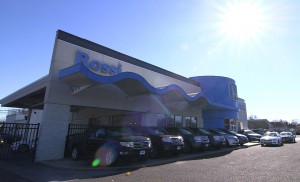Sales of new vehicles are expected to drop in April by between 2% and 3% year-over-year despite steadily rising incentives, according to estimates by Kelly Blue Book and J.D. Power, fueling concerns that the industry is facing a broad decline in 2017.
“After a weaker-than-expected March, it’s becoming more likely that 2017 will be the first down year for the industry since 2009,” said Tim Fleming, analyst for Kelley Blue Book. “Kelley Blue Book expects April to continue this downward trend, however, the SAAR should bounce back to approximately 17.1 million as a result of one less selling day.
“Beyond April, we will continue to closely monitor still high levels of inventory and elevated incentive spending by manufacturers, both of which are signs of overproduction following last year’s sales peak,” he added in his new analysis of industry sales trends.
KBB estimated seasonally adjusted annual rate at 17.1 million units during April. After a record year of sales in 2016 and seven consecutive year-over-year sales increases, KBB’s forecast for 2017 calls for sales in the range of 16.8 million to 17.3 million units, which represents a 1% to 4% decrease from last year.
(Chevy aims to top spot in brand sales. Click Here for the story.)
Incentive spending is at record levels through April, according to a forecast developed jointly by J.D. Power and LMC Automotive even though year-to-date retail sales increased by a slight 0.3% during the first quarter.
Retail sales in the month of April are anticipated to reach 1,169,700 units, a 1.3% increase compared with April 2016 on a selling day adjusted basis. Year-to-date, retail sales in 2017 are up 0.3% compared to the same period a year ago.
“While industry retail sales pace remains high, it is being powered by elevated levels of incentive spending which pose a serious threat to the long-term health of the industry,” noted Deirdre Borrego, senior vice president of automotive data and analytics at J.D. Power
“The total value of incentives used to sell new vehicles has increased by $1.9 billion through the first four months of the year,” she added.
Total incentive spending in the marketplace stands at $16.4 billion through April, up 13% from last year. On a per unit basis, spending for the average new vehicle through April was $3,814, up $460 from a year ago. On trucks and SUVs, spending was $3,740, up $578, while on cars, spending was $3,938, up $308.
(Click Here for more about rising dealer revenue and employment levels, but flat profits.)
In addition, despite record incentive levels, average days to turn continues to rise. Nearly 30% of vehicles sold in 2017 sat on dealer lots for more than 90 days, up from 27% last year.
The average new-vehicle retail transaction price to date in April is $31,380, a record for the month, surpassing the previous high for the month of $31,228 set in April 2016.
“With flat retail demand and inventory at record levels, manufacturers will continue to face a difficult choice between maintaining elevated incentives or making production cuts,” Borrego said.
Jeff Schuster, senior vice president of forecasting at LMC Automotive, said LMC is revising its forecast for total light-vehicle sales in 2017, with a reduction of 40,000 units to 17.5 million units and is now predicting a decline of 0.1% from 2016. The forecast for retail light-vehicle sales remains at 14.2 million units, an increase of 0.2% from 2016.
“Retail auto sales are performing as expected but non-retail sales have been slightly lower, which is the primary reason for total sales being down 1.4% year-to-date. But this is no time to hit the panic button,” Schuster said.
(What is the U.S. auto market likely to look like this year? Click Here for some educated guessing.)
“Economic and policy factors remain important in setting direction for the auto sector in the near-term, however, given the year-to-date performance, risk assessment is looking at internal factors like used car pricing, lease penetration and the interplay between vehicle inventory and incentives,” he added.

